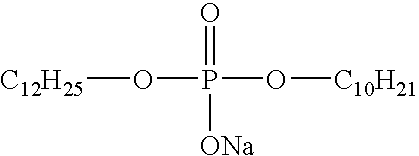Solution of cellulose acylate dissolved in mixed solvent comprising ketone and ester
a technology of cellulose acylate and mixed solvent, which is applied in the direction of photosensitive materials, pretreatment with water/steam, instruments, etc., can solve the problems of affecting the working environment, and affecting the quality of cellulose acyla
- Summary
- Abstract
- Description
- Claims
- Application Information
AI Technical Summary
Benefits of technology
Problems solved by technology
Method used
Image
Examples
example 2
[0168] (1-1) Preparation of Cellulose Triacetate Solution
[0169] A cellulose triacetate solution was prepared in the following manner. In a 2L stainless steel-made dissolution tank equipped with a stirring propeller, a mixture consisting of the below-described components was placed. (The tank was beforehand washed well with methylene chloride.) With the mixture vigorously stirred, powder of cellulose triacetate (mean particle size: 2 mm) was gradually added to make the total weight 1 kg. The mixture was then left at room temperature (25.degree. C.) for 3 hours, so as to swell the cellulose triacetate.
4 Cellulose triacetate (substitution degree: 2.83, water 20 weight parts content: 0.4 wt %, viscosity average degree of poly-merization: 320, viscosity of 6 wt. % methylene chloride solution: 305 mPa.s) Methyl acetate 48 weight parts Cyclopentanone 10 weight parts Methanol 5 weight parts Ethanol 5 weight parts Dipentaerythritol hexaacetate (plasticizer A) 6 weight parts Triphenyl phospha...
example 3
[0176] The process for preparing the sample 1-3 of Example 2 was repeated except that the cellulose triacetate solution of (1-2) was treated in the following manner, to prepare the sample 2-3.
[0177] The inhomogeneous cellulose triacetate solution of (1-2) in the form of gel was sent by means of a screw pump, to pass through a heating path heated and pressed at 180.degree. C. and 1 Mpa, respectively. In the heating path, the solution was heated and pressed to 110.degree. C. and 1 Mpa for 3 minutes, and then filtrated through filter paper having the absolute filtration precision of 0.01 mm (#63, Toyo Filter Co., Ltd.) and further filtrated through filter paper having the absolute filtration precision of 0.0025 mm (FHO25, Pole).
[0178] (2-1) Results
[0179] The prepared sample 2-3 of the invention was excellent in filtration, and left no flake on the support when peeled off. Further, the film made of the sample was excellent in unevenness, warts and haze. Thus, it was confirmed that the p...
example 4
[0180] The process for preparing the sample 1-3 of Example 2 was repeated except that neither the plasicizer A nor B was used, to prepare the sample 3-3. The sample left no flake on the support when peeled off. The film of the sample was classified as the grade A in terms of both unevenness and warts. The haze of the film was 0.3%, which was an excellent value. The results of the bending test were 103 times (sample 1-3) and 82 times (sample 3-3). Since the sample 3-3 contained no plasicizer, the bending strength of the sample 3-3 was slightly inferior. Although this inferiority practically causes no problem, this example indicates it is preferred for the film to contain a plasicizer.
PUM
| Property | Measurement | Unit |
|---|---|---|
| wt. % | aaaaa | aaaaa |
| temperature | aaaaa | aaaaa |
| temperature | aaaaa | aaaaa |
Abstract
Description
Claims
Application Information
 Login to View More
Login to View More - R&D
- Intellectual Property
- Life Sciences
- Materials
- Tech Scout
- Unparalleled Data Quality
- Higher Quality Content
- 60% Fewer Hallucinations
Browse by: Latest US Patents, China's latest patents, Technical Efficacy Thesaurus, Application Domain, Technology Topic, Popular Technical Reports.
© 2025 PatSnap. All rights reserved.Legal|Privacy policy|Modern Slavery Act Transparency Statement|Sitemap|About US| Contact US: help@patsnap.com


